�
�
�
�
�
�
� presented by: Ted Lathrop of Fast Cars Inc.
� coverage by: Curtis Jacobson�
� Ted Lathrop began his tech session by warmly endorsing the theme presented by Bill Guzman � in the preceding tech session: "Keep it simple!" Ted further expressed two common feelings � among our community: British sports cars were built to be fun and they were built to be driven. � Modifications we make to them should be completed with those goals firmly in mind.�
� The Fast Cars Inc. independent front suspension ("IFS") could be perceived as a very � simple and straightforward way to dramatically upgrade an MGB's handling to a higher, more � modern standard. After all, the IFS comes as one complete unit and installs with just four � bolts. Installing it seems so much easier than rebuilding a worn stock suspension! But � of course, the paradox is that engineering a front suspension is serious work. The purpose � of Ted's tech session was to walk us through his design process and to explain the theory � of operation behind his resulting design so that we might appreciate its potential benefits.�
�
�
�
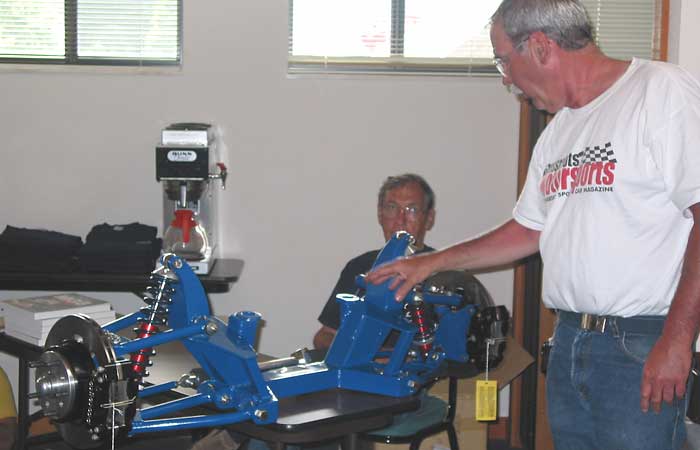
�
Ted Lathrop Explains the Fast Cars Front Suspension for MGB�
British V8 2006 Tech Session: MGB Front Suspension Upgrade
� as published in British V8 Newsletter, Volume XIV Issue 2, August 2006�� presented by: Ted Lathrop of Fast Cars Inc.
� coverage by: Curtis Jacobson�
� Ted Lathrop began his tech session by warmly endorsing the theme presented by Bill Guzman � in the preceding tech session: "Keep it simple!" Ted further expressed two common feelings � among our community: British sports cars were built to be fun and they were built to be driven. � Modifications we make to them should be completed with those goals firmly in mind.�
� The Fast Cars Inc. independent front suspension ("IFS") could be perceived as a very � simple and straightforward way to dramatically upgrade an MGB's handling to a higher, more � modern standard. After all, the IFS comes as one complete unit and installs with just four � bolts. Installing it seems so much easier than rebuilding a worn stock suspension! But � of course, the paradox is that engineering a front suspension is serious work. The purpose � of Ted's tech session was to walk us through his design process and to explain the theory � of operation behind his resulting design so that we might appreciate its potential benefits.�
�
There's no better visual aid than actual parts. Throughout the tech session we were able �
to examine the front suspension that will soon be installed under Rob Ficalora's �
Ford-powered MGB.�
� According to Ted, the first priority of his design was to reduce un-sprung weight. � ("Un-sprung weight" is the weight of all components from the suspension springs down � and outboard to where the tires contact the road.) Whereas any weight reduction will� make a car quicker, reduction of un-sprung weight particularly improves ride quality. � Ted didn't digress into a component-by-component weight comparison with the stock � suspension, but he did claim a dramatic savings of eighty pounds in total! �
��
�
Another design priority was accommodation of bigger, stronger brakes. The Fast Cars �
IFS comes with 11.75" Wilwood vented rotors and robust four-pot Wilwood "Dynalite" �
aluminum brake calipers. (Fast Cars also offers an 8" Ford-based rear axle assembly �
for MGB that utilizes Wilwood disc brakes.) The size of these brake components obliges �
users of the Fast Cars IFS to fit 15" wheels (or larger) in lieu of MGB's original �
14" wheels. Ted prefers fifteen inch tires anyway because they tend to iron-out the �
road surface in terms of perceived ride quality. The relatively high volume of the �
four piston calipers requires installation of a residual pressure valve in the brake �
system, but that installation is relatively cheap and easy. �
� A third design priority was to further improve ride-quality and handling by better � placement of the lower spring mounting point. The Fast Cars IFS incorporates � coil-over shock absorbers, and the coil-over shocks are mounted quite far out at � the lower end, so that the spring compresses relatively far for a given wheel � displacement, which in practical application means that 200 pound per inch springs � can be used instead of (the stock) 400 pound per inch springs. This geometry also � increases travel of the shock absorber's piston for any given bump, which is � advantageous.�
� Of course, coil-over shock absorbers have inherent advantages of their own. For one, � they facilitate very simple ride height adjustment, and even potentially the tuning of � "corner weights" so that the weight of the car is better balanced over the tires while � driving. Fast Cars utilizes lightweight Carrera aluminum-bodied shock absorbers. � Shock valving has been selected specifically for this application, so there's no need � for the valves to be driver-adjustable. �
� The original MGB suspension was designed for bias ply tires. (Remember those?) � It had about seven degrees of caster angle, which means that with modern radial � tires steering effort is relatively quite high. (Caster angle is the relative � angle of the kingpin or "steering pivot axis" to a vertical line as viewed from � the side of the car. Seven degrees was a lot, even by 1960's standards. The only � good, practical way to reduce a stock MGB's caster angle is to fit wedge-shaped � shims between the front suspension assembly and the rest of the chassis.) The � Fast Cars IFS has a nominal caster angle of three degrees, and like modern cars � the caster can be easily fine-tuned during alignment. The adjustment range is � 2.5 to 5.0 degrees. One characteristic of the Fast Cars IFS is very light, precise � steering. �
�
�
�
� According to Ted, the first priority of his design was to reduce un-sprung weight. � ("Un-sprung weight" is the weight of all components from the suspension springs down � and outboard to where the tires contact the road.) Whereas any weight reduction will� make a car quicker, reduction of un-sprung weight particularly improves ride quality. � Ted didn't digress into a component-by-component weight comparison with the stock � suspension, but he did claim a dramatic savings of eighty pounds in total! �
�
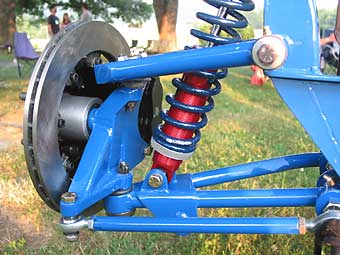 | �
� | 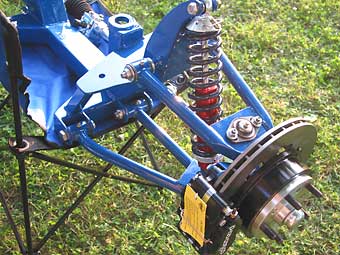 | �
| Lightweight components and fabricated 4130N spindles | �� | Nylatron GS bushes and lots of Zerk grease nipples! | �
� A third design priority was to further improve ride-quality and handling by better � placement of the lower spring mounting point. The Fast Cars IFS incorporates � coil-over shock absorbers, and the coil-over shocks are mounted quite far out at � the lower end, so that the spring compresses relatively far for a given wheel � displacement, which in practical application means that 200 pound per inch springs � can be used instead of (the stock) 400 pound per inch springs. This geometry also � increases travel of the shock absorber's piston for any given bump, which is � advantageous.�
� Of course, coil-over shock absorbers have inherent advantages of their own. For one, � they facilitate very simple ride height adjustment, and even potentially the tuning of � "corner weights" so that the weight of the car is better balanced over the tires while � driving. Fast Cars utilizes lightweight Carrera aluminum-bodied shock absorbers. � Shock valving has been selected specifically for this application, so there's no need � for the valves to be driver-adjustable. �
� The original MGB suspension was designed for bias ply tires. (Remember those?) � It had about seven degrees of caster angle, which means that with modern radial � tires steering effort is relatively quite high. (Caster angle is the relative � angle of the kingpin or "steering pivot axis" to a vertical line as viewed from � the side of the car. Seven degrees was a lot, even by 1960's standards. The only � good, practical way to reduce a stock MGB's caster angle is to fit wedge-shaped � shims between the front suspension assembly and the rest of the chassis.) The � Fast Cars IFS has a nominal caster angle of three degrees, and like modern cars � the caster can be easily fine-tuned during alignment. The adjustment range is � 2.5 to 5.0 degrees. One characteristic of the Fast Cars IFS is very light, precise � steering. �
�
�
There are two other basic alignment specs: camber and toe-in. The Fast Cars IFS �
is designed to have very little static camber... somewhat less than the MGB stock �
suspension's nominal one degree spec. (Camber is the relative angle of the steering �
pivot axis to a vertical line as viewed from the front or rear of the car, and of �
course it changes with body roll as a function of suspension geometry. When a �
suspension is designed to work well with lower static camber, it typically will �
also benefit in better tire life and straight-line braking.) Ted recommends very �
little toe-in on radial-tire equipped MGB cars: just one thirty-secondth to one �
sixteenth of an inch.�
� As briefly alluded to above, the relative location of suspension pivot points defines � the characteristic way tire/wheel camber changes in roll for that suspension. That's � very important, but the pivot point locations do more than just that. For example, by � virtue of the relative placement of A-arm attachment points, the Fast Cars front � suspension has some "anti-dive" built in. "Dive" is the tendency for the front end of � a car to go down when brakes are applied. Stock MGB suspensions dive quite noticeably, � as do all other cars of their era. In more modern cars it's typical to arrange the � suspension geometry so that the upward force of brake torque reaction opposes the downward � force of load transfer, at least to some significant extent (like maybe 25 percent). � This characteristic has become common in modern cars because it makes the cars a little � more pleasant to drive. (The Ford "Mustang II" front suspension introduced anti-dive to � hot-rodders, and anti-dive has been a popular feature on hot-rods ever since.) �
� Another interesting characteristic of the Fast Cars front suspension geometry, as Ted � explained it, is that the "roll center" for the front suspension is significantly higher � than for the stock MGB front suspension. I don't know if I can explain properly, but � I'll try. The front and rear suspensions on a car have two different roll center heights.� The rear suspension of a leaf-spring rear-suspension car, such as an MGB, has its roll � center location at axle height (unless extra links such as a Panhard rod have been � fitted). If you draw an imaginary line from front suspension roll center to rear � suspension roll center, that line defines a "roll axis" for the car. The roll axis of � a car is the imaginary axis around which the body (or rather the "sprung mass") of the � car pivots as the vehicle corners. Ted explained that he deliberately placed the front � roll center substantially higher than stock to level the roll axis.�
� The Fast Cars front suspension accepts the same anti-sway bars as the stock MGB suspension. �
��
�
The rack-and-pinion steering gear that Fast Cars uses is custom-made for their IFS. �
It requires an intermediate shaft and u-joints to connect to the MGB steering column. �
Customers may fabricate their own, or buy a custom-made intermediate shaft from Fast Cars. �
� New this year! Ted announced that he is now offering the IFS with motor mounts � pre-installed for easy installation of Ford 5.0 engines. He is also offering the � IFS in a second, two-inch wider track width for customers who are fitting fender � flares. Finally, the IFS may be ordered pre-painted to match the car. (Rob's � suspension demonstrated the Ford motor mounts and custom paint options.) Do you have � any other special requests? Fast Cars would like to work with you.�
��
�
� Other new products that Fast Cars Inc. is now offering include a cross-flow aluminum � radiator for MGB and nifty stainless steel block-hugger headers for Ford 5.0 V8 � conversions. (The left-hand and right-hand headers are slightly different to provide � extra clearance to the motor mounts.) �
� Ted also announced that a three-link rear suspension for MGB is in development. �
�
�
�
� As briefly alluded to above, the relative location of suspension pivot points defines � the characteristic way tire/wheel camber changes in roll for that suspension. That's � very important, but the pivot point locations do more than just that. For example, by � virtue of the relative placement of A-arm attachment points, the Fast Cars front � suspension has some "anti-dive" built in. "Dive" is the tendency for the front end of � a car to go down when brakes are applied. Stock MGB suspensions dive quite noticeably, � as do all other cars of their era. In more modern cars it's typical to arrange the � suspension geometry so that the upward force of brake torque reaction opposes the downward � force of load transfer, at least to some significant extent (like maybe 25 percent). � This characteristic has become common in modern cars because it makes the cars a little � more pleasant to drive. (The Ford "Mustang II" front suspension introduced anti-dive to � hot-rodders, and anti-dive has been a popular feature on hot-rods ever since.) �
� Another interesting characteristic of the Fast Cars front suspension geometry, as Ted � explained it, is that the "roll center" for the front suspension is significantly higher � than for the stock MGB front suspension. I don't know if I can explain properly, but � I'll try. The front and rear suspensions on a car have two different roll center heights.� The rear suspension of a leaf-spring rear-suspension car, such as an MGB, has its roll � center location at axle height (unless extra links such as a Panhard rod have been � fitted). If you draw an imaginary line from front suspension roll center to rear � suspension roll center, that line defines a "roll axis" for the car. The roll axis of � a car is the imaginary axis around which the body (or rather the "sprung mass") of the � car pivots as the vehicle corners. Ted explained that he deliberately placed the front � roll center substantially higher than stock to level the roll axis.�
� The Fast Cars front suspension accepts the same anti-sway bars as the stock MGB suspension. �
�
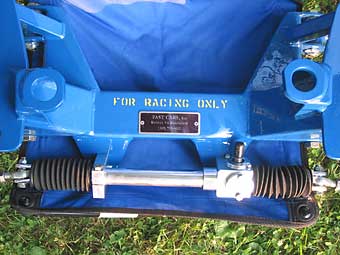 | �
� | 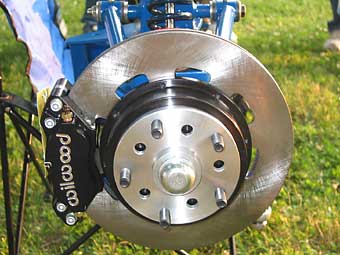 | �
| Optional pre-installed motor mounts for 302 Ford | �� | Specify any wheel-stud spacing you desire | �
� New this year! Ted announced that he is now offering the IFS with motor mounts � pre-installed for easy installation of Ford 5.0 engines. He is also offering the � IFS in a second, two-inch wider track width for customers who are fitting fender � flares. Finally, the IFS may be ordered pre-painted to match the car. (Rob's � suspension demonstrated the Ford motor mounts and custom paint options.) Do you have � any other special requests? Fast Cars would like to work with you.�
�
| �
Enjoying this article? Our magazine is funded through the generous support of readers like you! � To contribute to our operating budget, please click here and follow the instructions. � (Suggested contribution is twenty bucks per year. Feel free to give more!)� |
� Other new products that Fast Cars Inc. is now offering include a cross-flow aluminum � radiator for MGB and nifty stainless steel block-hugger headers for Ford 5.0 V8 � conversions. (The left-hand and right-hand headers are slightly different to provide � extra clearance to the motor mounts.) �
� Ted also announced that a three-link rear suspension for MGB is in development. �
�
�
For anyone interested to see the Fast Cars IFS installed, the meet provided ample opportunity �
for that too. Steve Carrick, Robert Milner, Pete Mantell, and Mikel Moor have all fitted �
the suspension and this author managed to test drive three out of their four MGBs by the �
end of the meet. This suspension really works! In this author's opinion, lighter �
steering effort is the single most obvious difference from stock (at least when you're driving �
someone else's car gently.) That's the first characteristic I noted in all four cars. �
I drove the cars too gently to honestly evaluate other characteristics as I would have liked to �
- and I'm not the keenest test-driver anyway...�
� But Mikel Moor has had the Fast Cars IFS installed now for over two years, and his comments � were typical of what I heard: "I'm still totally excited over it! There's no bump steer, and � (highway) expansion joints seem to have just melted away. At the Putnam Park race track I was � able to just drive my line without fuss - FAST! - and without tire squeel. At lower speeds � I really notice that the Ackerman angles seem to be worked-out better. The tires don't seem � to be scrubbing at low speed and I notice that I've got more wheel-cut too." �
� I wish I'd had a pen with me when Robert Milner came down off "The Tail of the Dragon" - he � was so pleased with his recently installed Fast Cars IFS that he was chattering and bouncing � up and down like a kid! �
� Disclaimer: This page was researched and written by Curtis Jacobson. Views expressed � are those of the author, and are provided without warrantee or guarantee. Apply at your � own risk.�
� Photos by Curtis Jacobson. All rights reserved. �
�
�
� But Mikel Moor has had the Fast Cars IFS installed now for over two years, and his comments � were typical of what I heard: "I'm still totally excited over it! There's no bump steer, and � (highway) expansion joints seem to have just melted away. At the Putnam Park race track I was � able to just drive my line without fuss - FAST! - and without tire squeel. At lower speeds � I really notice that the Ackerman angles seem to be worked-out better. The tires don't seem � to be scrubbing at low speed and I notice that I've got more wheel-cut too." �
� I wish I'd had a pen with me when Robert Milner came down off "The Tail of the Dragon" - he � was so pleased with his recently installed Fast Cars IFS that he was chattering and bouncing � up and down like a kid! �
� Disclaimer: This page was researched and written by Curtis Jacobson. Views expressed � are those of the author, and are provided without warrantee or guarantee. Apply at your � own risk.�
� Photos by Curtis Jacobson. All rights reserved. �


